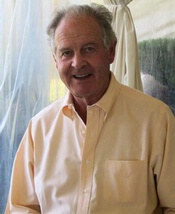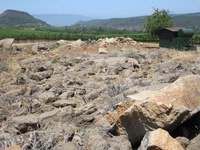|
|
 |
.jpg)
Last month on a sunny Napa Valley day, Piero Antinori was explaining how he and his family came to own Antica Napa Valley, a 1200-acre property at the end of Soda Canyon Road in the Atlas Peak American Viticultural Area. In 1985, he was scouting potential vineyard and winery investment properties for a partnership that included his importer, Whitbread. “I fell in love with the place. It reminded me of some of the  hills of Tuscany.” It’s easy to see why Antinori was drawn to this Foss Valley property. It shares similarities to his famous Tignanello vineyard in the heart of Chianti Classico: Lots of rocks and elevations over 1100 feet. hills of Tuscany.” It’s easy to see why Antinori was drawn to this Foss Valley property. It shares similarities to his famous Tignanello vineyard in the heart of Chianti Classico: Lots of rocks and elevations over 1100 feet.
Antinori, of course, is Marchese di Antinori of the Tuscany-based family with multiple winery estates: In Italy, Peppoli, Tignanello (the Solaia vineyard is also on this estate), Antinori nel Chianti Classico, and Badia a Passignano in Chianti Classiso; plus Pian delle Vigne in Brunello di Montalcino, Giuado al Tasso in Bolgheri, and Casteollo dellla Sala in Umbria; Col Solari on Red Mountain in Washington…and Antica Napa Valley. The Antinori family’s winemaking history goes back 26 generations. Today, their wine empire is headed by the Marchese and his three daughters, Albiera, Allegra and Alessia.
I remember all the initial fuss about Piero Antinori acquiring a property on Atlas Peak to plant Sangiovese. You figure, if anyone knows how to make a good Sangiovese wine in California, it would be Antinori. However, it turns out that Sangiovese is not the focus here today. Antinori took full ownership of the estate after buying out the partners in 1993 and took full control at the expiration of a lease of the vineyards in 2008, thus creating Antica. Now more than 50 percent of the vineyards are planted with Cabernet Sauvignon, a bit over 26 percent to Chardonnay, almost 11 percent Merlot, plus a smattering of eight other varieties including three percent Sangiovese.
We gathered to learn about a 24-acre, unplanted addition to the estate that was purchased from neighbor June Townsend in 1998. Those 24 acres were named in her honor, and they was planted with Cabernet Sauvignon in 1999. The lessons learned by the Antinoris from their experience in creating the high quality wine of Tignanello were applied to the development of this vineyard.
Antinori recounted the replanting of the Tignanello vineyard and the wine’s first vintage in 1971, saying that it represented “The beginning of the new Renaissance of Italian wine. For many years the focus for Italian wine was low price and low quality. In the 1960s, we replanted the Tignanello vineyard. With the help of Emile Peynaud [a legendary French enologist who taught vintners around the world how improve the quality of grape growing and winemaking], we investigated all the ways to make high quality wine. We planted Sangiovese and, at the suggestion of Peynaud, Cabernet Sauvignon--a grape that my father experimented with in the 1930s. We planted 80 percent of the vineyard to Sangiovese, 15 percent to Cabernet Sauvignon and 5 percent to Cabernet Franc.”
Of course, this mix of grapes did not conform to Chianti Classico regulations, so they labeled that first wine as a Vino da Tavola.
The vineyard has a southwest exposure, steep drainage and it’s full of rocks, but different kind of rock than Townsend vineyard. “We first tried to remove the rocks when we were renovating the Tignanallo Vineyard,  but instead of removing them, we broke them up and spread them in the vineyard to reflect heat and light for full ripening of the grapes. At 1,150 and 1,312 feet elevation we sometime have trouble ripening,” he said. but instead of removing them, we broke them up and spread them in the vineyard to reflect heat and light for full ripening of the grapes. At 1,150 and 1,312 feet elevation we sometime have trouble ripening,” he said.
Townsend vineyard is also full of rocks, but volcanic ones, as opposed to the limestone rocks of Tignanello. “It was a lot of work to move the rocks, to break them up,” said Antinori, “but the drainage is fantastic.” Also important is how the rocks affect the temperature of the vineyard. “The basalt rock receives heat during the day and releases it at night.” The 1,800 feet altitude puts the vineyard above the fog line, as well as providing cooler daytime temperatures than lower Napa elevations.
Antinori has a winemaking philosophy that was easily applied to Townsend; for example, high density planting for low vigor vines. The Townsend crop level is three pounds of grapes per vine, which is equal to one bottle of wine, so each vine stands as the source for a single bottle of wine. “Diversity for complexity” is a principle embodied by having five different Cabernet clones, each with the best rootstock for the clone and the soil. For Tignanello and Townsend vineyards, if the wine quality of a given vintage does not meet Antinori standards, they don’t make those wines.
The day also provided a privileged opportunity to experience the iconic Tignanello from ages three to 17. As we tasted, Antinori briefly described the vintages. He called 2011 one of the most difficult vintages, requiring particularly careful fruit selection and precise handling in the winery. The fresh, dark plum fruit showed a bit of mint and was elegantly balanced with bright acidity and dusty tannins, although it needs more time in the bottle. The 2007 vintage was a good one with low yields, perfectly ripened Sangiovese, and great potential. The fruit was concentrated, intense and spicy with just a bit of mintiness, finishing with sturdy, ripe tannins. In 2004 it was cool with plenty of rain, so harvest was about two weeks later than usual. The wine showed dense, dark color with sweet, black cherry and coffee flavors fruit and chewy tannins. The 1999 was a lighter vintage due to the weather. The dark fruit aromas had cedar notes of bottle age, the palate was smooth and savory with subdued mushroom flavors, though the wine finished a bit short. Antinori described the 1997 vintage as a classic. The wine was showing some browning around the edges, while the aromas were savory and smoky with sandalwood notes. The wine was bright on the palate with integrated tannins.
When asked about his favorite, Antinori replied, “My favorite wine is one, like every producer, that I have not made yet.”
We then tasted five vintages of the Cabernet Sauvignon from Townsend guided by estate manager Glenn Salva. Winemaking at Antica is in the hands of Renzo Cotarella (Antinori’s chief enologist) and Antica winemaker Nate Weis. In Townsend’s inaugural year of 2008, only 22 percent of the harvest went into the wine. It was showing well, with youthful blackberry, cassis, black cherry fruit lifted by tangy acidity and supported by chewy tannins. The 2009 vintage yielded ideally ripe grapes, which were carefully selected to ensure uniformly ripe grapes for the wine. Again that lovely blackberry, cassis, black cherry fruit along layered with coffee, dark chocolate and savory, dusty mineral notes. It was elegantly balanced.
The highlight for me was the 2010, with seamlessly integrated blackberry, cassis mocha fruit, vivid acidity and ripe tannins. Salva declared the 2012 growing year a great one with nature providing all that was needed to produce perfectly ripe grapes. As might be expected from a young, ripe, Napa Valley Cabernet, the fruit was lush and round, with wisps of smoke and dusty tannins. A 2013 barrel sample was the offspring of a drought year made from very small berries showing dark, rich, opaque color, concentrated blackberry, black cherry fruit and sturdy tannins.
It was clear from the wines we tasted that Townsend needs time and does develop well with age. Antinori noted “For a red wine to be great, it has to have aging potential.”
Obviously, Tignanello and Antica’s Townsend Vineyard Cabernet Sauvignon are two very different wines, from different parts of the world and different grapes, but they do have a familial resemblance. They are both wines with great pedigrees, raised with careful and thoughtful expertise, in highly-esteemed growing regions, made with the resources of a historical winemaking family.
|
 |
|